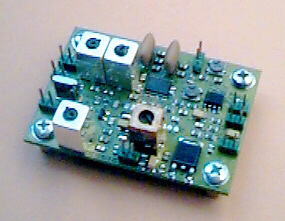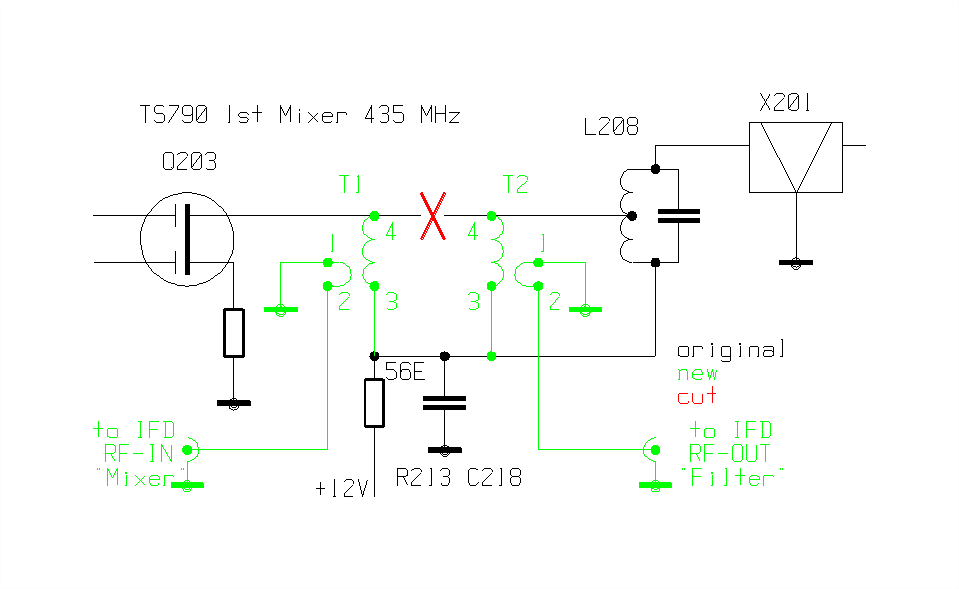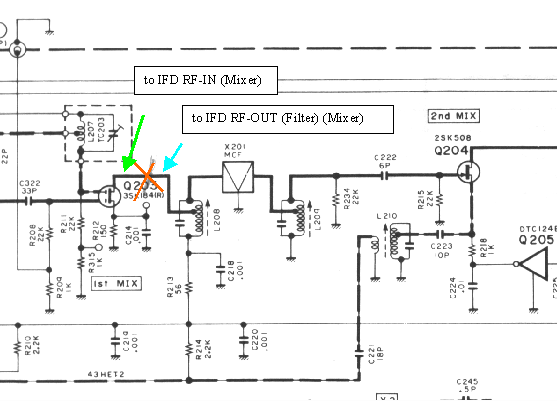

Insert the IFD between 1st mixer and IF-filter. The filter input impedance is 450 Ohm, so you need a pair of 1:3 (50:450 Ohm) transformers.
Uplink (TX): any frequency (144-146 MHz, 430-440 MHz etc.),
FSK-modulation 4800 up to 19200 kBaud,
Downlink (RX): 430-440 MHz, 38400/76800 Baud FSK (153 kBaud with wider filters
(optional)).
Material required (included in the package):
| SYMEK IFD-B-amplifier-mixer-demodulator board option 'TS790' | |
| two 1:3 rf micro-transformers, 2x30cm thin coax cable, wire, shielded audio cable and other hardware, heatshrink tube and other parts as needed. The transformers are marked "7003* NEOSID". The both 50 W pins are located at the side with the dot and the '7003' text, the 450 W pins at the side with 'NEOSID' text on the upper side. In other words: If the pin marked with the dot is assumed pin 1 and the pins are counted counter-clockwise (as usual with IC), the 50 W input is pin1+2 and the output is pin 3+4. However, the text would be bottom up if you have pin1 (dot) oriented to the left. The transformer has a winding ratio of 1:3, which results in a impedance ratio of the square, which is 1:9. With 50 W at pin 1+2, the impedance at the pins 3+4 is 450 W to match the filter. |
1. Transmitter (modulation):
The TS790 can be simply modulated with up to 19200 Baud if the following modifications are made:
Open carefully the transceiver case (bottom). Locate the connector 31 (FMD=frequency modulation). The crystal oscillator 10.605 MHz) is located nearby. The connector is at the rear left side of the large IF-board.
(Schematics: The modulator / varactor diode in TS790 transmitter oscillator)
Solder a 10 kOhm resistor to the white wire which goes to the signal pin of connector 31. The other end of the resistor is soldered to the inner connector of a 30cm shielded audio cable. The shield is connected to ground (e.g. at connector 31, black wire).
For acessing this signal, ACC4 pin 3 could be used. This pin is not used with the original transceiver.
2. PTT (transmitter keying):
Pin 8 of the ACC4 connector is already available as PTT connection for keying the transmitter.
3. Demodulator output:
Open the top cover of the transceiver (front towards you). Locate the RF 430 MHz unit: it is found at the right side below the power amplifier unit. To access the RF 430 unit, you have to remove all screws around the cast aluminium assembly, including two screws at the rear panel. The RF430 unit is fixed at the same cast aluminium part as the power amplifier but bottom-up. The aluminium part can be turned with the plastic hinges so that the RF430 unit becomes easily accessible.
The total RF 430 unit is shielded with a tin cover. Remove this cover (many screws) first and totally remove the printed circuit board. (some of the cables have to be plugged-out). You will have to make changes at the solder side of this board:
Locate the dual gate FET mixer Q 203. (see photo, under L208). The drain of Q 203 goes originally only to a tap of L 208. You have to carefully cut this trace between Q203 and L208.
(Color photo: the IF board , solder side of TS790 showing the transformers and cables to IFD)
(Color photo: the IF board solder side magnified showing where to cut the trace)
Solder side of RF 430 unit with the added transformers. You can see where to cut the trace (lower picture, center)
Note: the new SMD-type transformes look very different and are connected with short 0.3 mm copper enamelled wires similar to the toroids shown here.
(Color photo: Top side of the transceivers case,where the IFD can be installed bottom-up.)
Connection to mixer output:
Use a 3:1 step down transformer. Connect one of the 450 ohm input pins to the drain of Q 203, where the tap of L208 was connected before. The other 450 Ohm pin is soldered to the joint of R213 (56 Ohm) / C218 and L208. Connect the 50 ohm side of the transformer to a thin 50 ohm coax cable. Cable shield is soldered to ground. So, the FET is supplied via the 450 Ohm winding with power.
Feed the cable marked "mixer" below the fan motor to the bottom compartment of the transceiver.
 Version
Schematics: Insertion of IFD with 1:3 transformers 50:450 Ohm
Version
Schematics: Insertion of IFD with 1:3 transformers 50:450 Ohm
Note: with the SMD-transformers, the input and output is not dc-coupled. The 50 Ohm in and out is just the 50 Ohm winding of the transformers. The 50 Ohm side of both transformers go to the input and output of the IFD via a thin 50 Ohm coax cable. The other pin of the 50 Ohm windings are connected to ground.
Connection to filter input
Use a 1:3 step up transformer. Solder the 450 ohm output to the tap of L208 (where the Q 203 mixer was connected before), the other pin to the joint of R213 (56 Ohm) / C218 and L208. Connect the 50 ohm input of the transformer to a thin 50 ohm coax cable. Cable shield is soldered to ground.
Feed this cable, marked "filter" below the fan motor to the bottom compartment of the transceiver.
Carefully reinstall the RF 430 MHz board. Use insulating tape to avoid short circuits and damage of the transformers at the solder side of the board.
Important: Due to the differences in impedance, L208 needs to be readjusted now. Receive a weak signal and carefully turn the core of L208 to maximum S-meter reading if the transceiver.

Installation of the IFD board
There is a corner at the bottom compartment of the TS790, where you can easily install the little IFD circuit board: Find the unused hole with a M 2.5 thread in the frame of the transceiver. It is in the front left corner (transceiver bottom up). You can directly fix the IFD to the spare thread using a single M 2.5 x 6 screw. As the IFD is mounted top-down, you have to solder all connections before:
1. solder the coax cable "mixer" to the RF-IN (terminal M1) (shield to M2)
2. solder the coax cable "filter" to the RF-OUT (terminal M11) (shield to M12)
3. solder a 30 cm red wire to terminal M90 (+12V). The other end of this wire is soldered to Pin 7 of the ACC4 connector at the rear side of transceiver. (permanent 12Volt connection)
4. The demodulator output (terminal M63, data out) goes to ACC 4 Pin 5 (originally unused) via a thin shielded audio cable.
5. Ground connection for power supply is not necessary (cable shields are already grounded).
(Picture: Component layout of the IFD board)
4. Connection of the packet-radio-controller (TNC):
You need a 3 wire + screen cable from the TS790 to the packet controller. When using the 8 pin DIN Type H (pins not arranged in a circle, pin 6+7 are nearer to circumference) connector ACC 4 connector as described above, you only need an apropriate cable between the ACC 4 connector and TNC:
Pin 2: Ground (connect to TNC pin 2 GND
Pin 8: (center pin) PTT (connect to TNC pin 3: PTT)
Pin 3: Modulation (connect to TNC pin 1: Mod)
Pin 7: 12,5 Volt supply (not used)
Pin 5: data output (connect to TNC pin 4: Demod)
(RSSI output may be connected elsewhere if necessary)
5. Setup and test:
Before reinstalling all covers, check if the transceiver works exactly as before. For best RX sensitivity, the resonant circuit L 208 needs to be readjusted: Apply a 1 to 10 microvolt signal and tune L 208 to maximum S-meter reading. Because of the additional IF amplifier, the s-meter may show few dB difference.
In the Kenwood service manual 430 Mhz receive system sensitivity adjustment is as follows:
1. apply 3.2-100 uV FM signal, 1 Khz modulation, 5 Khz deviation (I used 3 uV at 440 Mhz).
2. Tune, in sequence, L214, L215, L210 for maximum S-meter reading, then repeat
3. Tune, in sequence, L211, TC203, L208, L209 for maximum S-meter reading, then repeat
It requires this full series for me to get the sensitivity back up. Just adjusting L208 only helps a very little. TC203 was a big help! These really are easy adjustments. Only L209 is a little "touchy", the others are broader at the peak. Although the service manual is quite specific about signal level, deviation, etc. I suspect the average ham could do this with any weak, constant strength signal source in the 435 Mhz band.
Adjust the output level of the TNC to get the desired frequency deviation / modulation index. Do not overmodulate as the transceiver will totally switch off the modulator. The modulator should work perfectly for all FSK baudrates from 9600 to 19200 baud. Note: the input voltage determines the bandwidth of the transmit signal. You will need more signal amplitude for higher baudrates.
The RSSI output should be near zero volts (<0.1 m V signal) and go up to 4 volts (1 mV rf input)
When receiving a 19200, 38400 or 76800 baud signal, there will be a perfect eye at the data output. The output voltage at 38400 Baud is typically 0.5 volt pp.
6. Questions and Answers:
Q: why is the IF signal fed through the IFD? Wouldn't it be
easier to connect the IFD in parallel to the mixer output?
A: directly after the mixer, the signal passes a quartz filter. As with every
filter, the input impedance varies significantly with frequency: within the
passband, the filter is matched, outside the passband, the filter reflects the
signal. The amplitude spectrum at the filter input shows a sharp notch at the
passband. Attaching a parallel demodulator here would cause severe distortions
due to the varying load. So, the signal after the mixer has to be buffered. The
amplified signal is attenuated again to get the same (or a few dB more) signal
level as without amplifier.
Q: is a AFC output available?
A: There is an unconnected pair of pins on the printed circuit board (M60/M61). These pins can be connected to the joint of R52/C52 (DET out) via a 100 kW resistor to pin M60. The voltage measured at this pin will depend on the center frequency of the received FM signal.
Q: how do I decode a fast packet-radio signal of 38kBaud or more?
A: The TNC2 with the Z80 processor cannot decode signals beyond 19200 Baud. The newer TNC3 or TNC31 series is capable of receive and transmit baudrates up to 1 Mbit/s. There are modems with all common baudrates (9600, 19200, 38400, 76800, 153600 and above). Special modems with different RX and TX speed (e.g. TX 9600 / RX 38400 for UO-12) are also available. When using WISP software with a TNC3 packet controller, you may use the modem 2 for receiving and modem 1 for transmitting. As WISP uses kiss-mode, both modems are received simultaneously, the data will be transmitted via the default port 1.
(Schematics: IFD-board)
Modifications IFD option TS790: Oscillator: quartz TQ730518 / 65,225 MHz for IF 75,925 MHz (standard), R80: 560Ohm, L80: 0,33 uH, C80: 22pF, C81: 33pF, C82: 33pF. Values for the band filter: C10: 68pF, C11: 12pF, L12: 0,33uH, C12: 2.2pF, (C13: 2,7pF), L13: 0,33uH, C14: 22pF, C15: 22pF.
Between joint U1 Pin 3 / R10 and the joint C11 / C10 a 22 Ohm resistor was added to reduce influence of the filter input impedance on amplifier gain.
(IFD Component layout and terminal location)